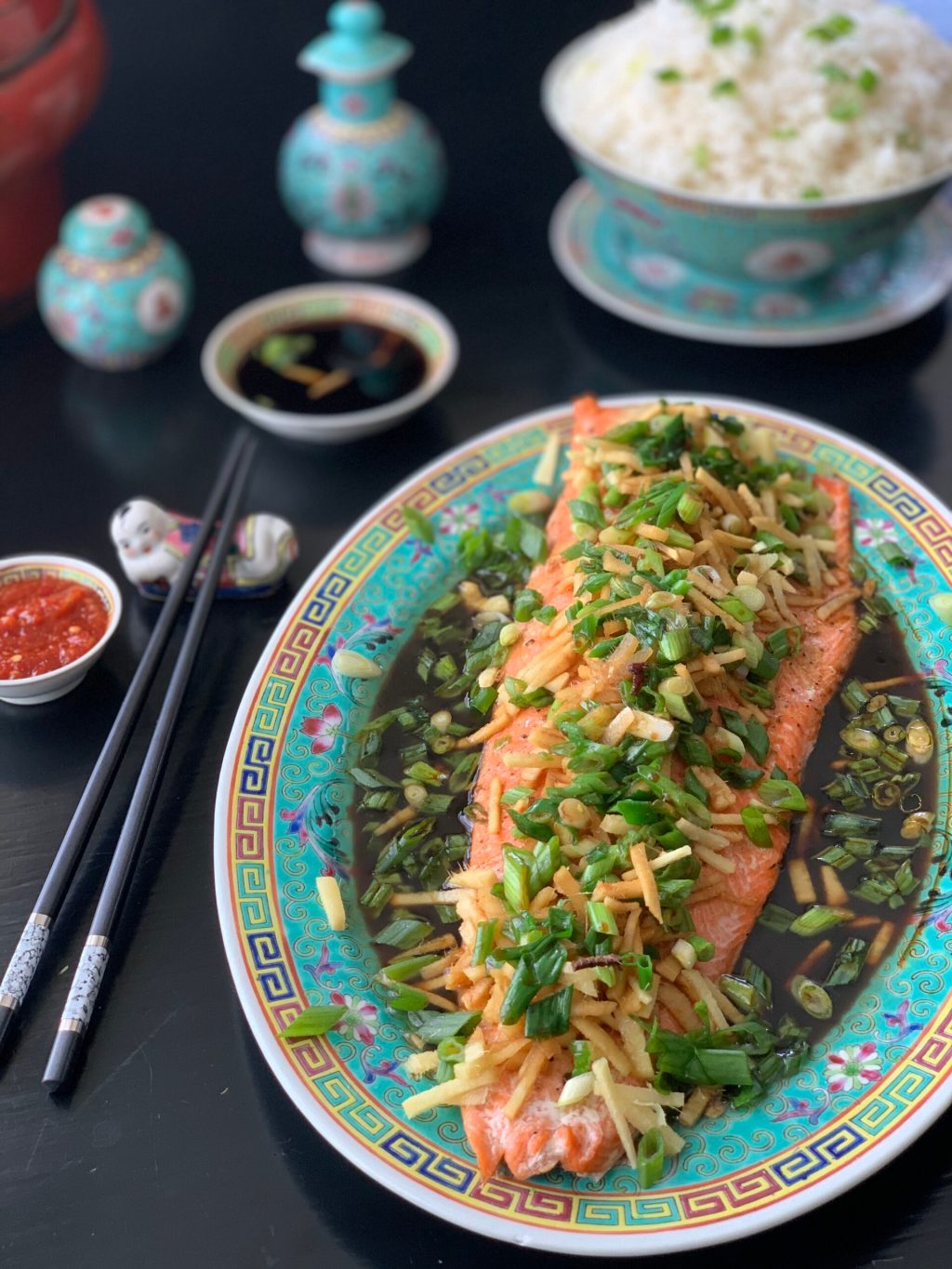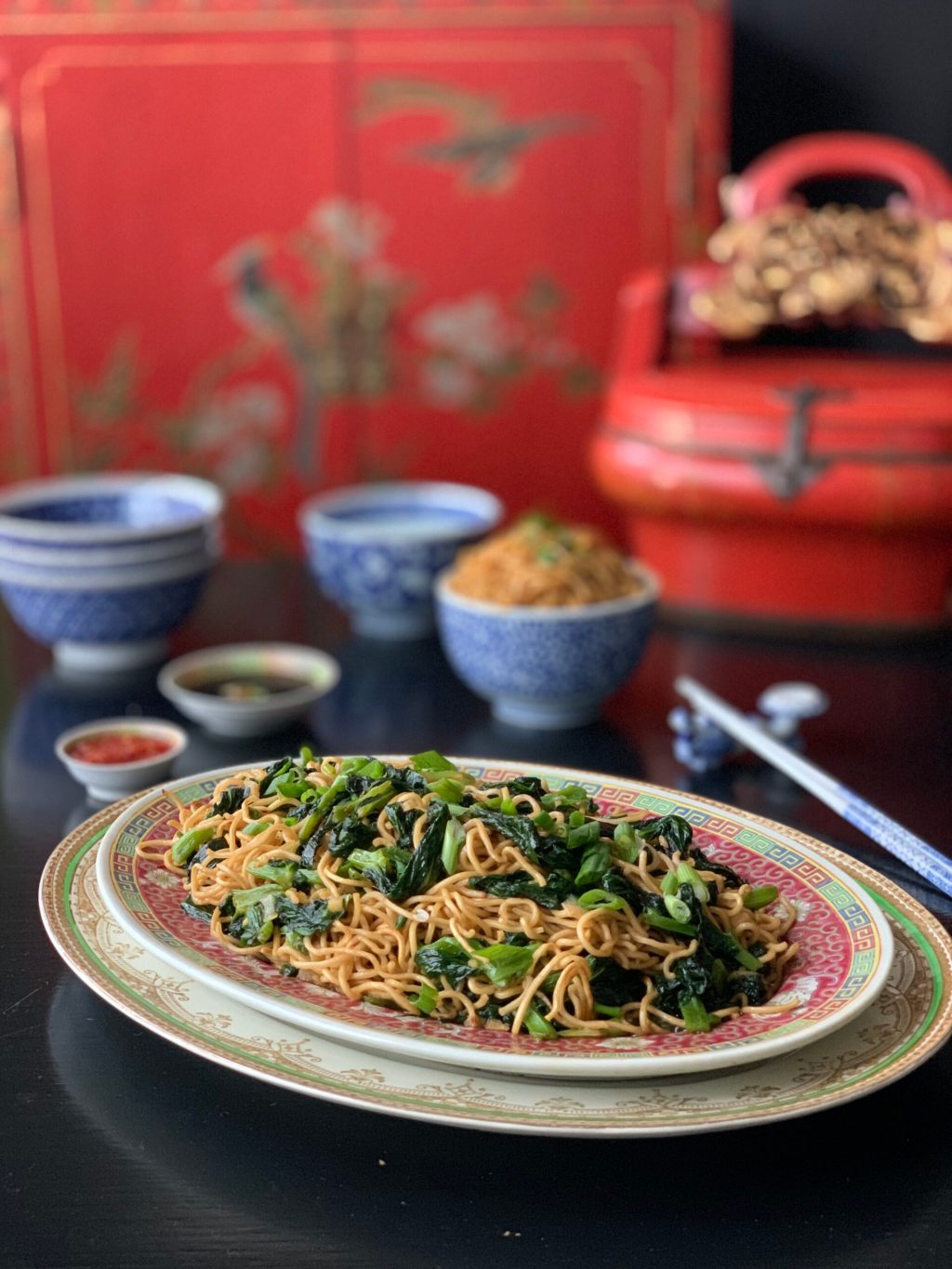Lunar New Year Recipes

Are you looking for some wildly delicious Lunar New Year Recipes? Do you wonder about the meaning of the foods eaten to celebrate Lunar New Year? We are happy to share both the meaning of those foods and a few recipes from our president, Karen Anderson’s, cookbook, Eat Alberta First.
Food Symbolism at Lunar New Year
Alberta is home to many immigrants of Asian descent and Lunar New Year is widely celebrated. The date varies each year according to the lunar calendar. Families gather to exchange gifts and usher in happiness, health and prosperity for a new year by eating certain foods.
Fish is eaten for prosperity in the new year because in Cantonese, “fish” (鱼 Yú /yoo/) auspiciously sounds like wishes and abundance. Long Noodles are eaten as they represent a nice long life. Greens represent good fortune in your life. Serving a whole chicken is a visual signifier of unity and since togetherness is the overarching theme of Lunar New Year celebrations, serving a whole chicken symbolizes the reunion of family. The more dumplings eaten, the more wealth to a person because dumplings were shaped like currency. Citrus fruits represented a round and full life. What follows are a few recipes from our friends, the Seto family, who lived part of this history.
Lunar New Year Recipes

Salmon Filet with Sizzling Oil, Ginger and Scallions
Makes: 4 to 6 servings
Takes: 20 minutes
Ingredients:
Three 2-inch long knobs ginger root
1 bunch scallions (green onions)
2 lb salmon filet (sockeye or coho)
Olive oil
Salt and pepper, to taste
⅓ – ½ cup canola or olive oil
½ cup soy sauce
Instructions:
- Preheat the oven to 400℉ and line a rimmed baking sheet with two pieces of aluminum foil folded in on each side so it becomes a tray to hold the salmon.
- Peel the ginger and cut it in ⅛-inch diameter rounds. Then, cut the rounds into ⅛-inch wide by 1-inch long matchstick pieces. Set aside.
- Clean and chop the top and bottoms off the scallions and then slice them thinly on the diagonal. Set aside.
- Rinse the salmon under cold running water and pat it dry with a paper towel. Lay it skin side down on the foil, rub it with a little olive oil and sprinkle it with salt and pepper to taste.
- Place the baking sheet with the salmon on the middle rack in the oven and bake for 10 minutes per inch of thickness. Meanwhile, slowly heat the canola oil in a small saucepan over medium heat. You know it is hot enough to pour over the fish when you drop a sliver of ginger in the oil and it sizzles. Pro Tip: do not leave the oil unattended on your stove and do not use high heat. If the oil boils or starts to smoke, you’ve got it too hot and there’s danger it might catch fire. So, go low and slow and it will be ready when the salmon is.
- Remove the salmon from the oven when it’s still a bit pink in the middle but otherwise cooked through. Transfer it to a serving platter and spread the ginger in a row down the center. Carefully pour the hot canola oil over the ginger, sprinkle the green onions and finish by pouring the soy over everything.
- Enjoy immediately with steamed rice and sides of chili paste and soy.
Long Life Noodles with Greens
Makes: 4 to 6 servings
Takes: 20 minutes
Ingredients:
3 – 4 cups washed greens (pea shoots, Chinese broccoli, and/ or baby bok choy)
1 (1 lb – 450 gram) package fresh Hong Kong style chow mein noodles
½ cup sherry
½ cup soy sauce
¼ cup Tablespoons sesame oil
4 teaspoons sugar
2 teaspoons chili paste
1- 2 Tablespoons canola oil
2 cloves garlic, sliced
2 Tablespoons chopped ginger
1 cup scallions (green onions), chopped on the diagonal
Instructions:
- Bring a large pot of water to boil, add the greens and cook just until they turn bright green. Remove them and plunge them into a large bowl of ice and water so they stop cooking and retain their colour. Once chilled, drain them and spin them in a salad spinner to remove the excess water. Set them aside.
- Prepare the noodles by soaking them in hot water for 5 minutes, then separate them gently without breaking them, and drain and dry them with a paper towel. Set aside and make the sauce.
- Whisk the sherry, soy, sesame oil, sugar and chili paste together in a bowl. Set aside.
- Heat a heavy-bottomed wok on high heat and add a Tablespoon of the canola oil, tilting to coat the sides, and continuing to heat until it’s at the smoke point. Pro Tip: you’ll definitely want the hood fan on high for this.
- Add the noodles and use tongs to turn them until they’re a bit crispy and heated through. Remove them to a bowl and set aside.
- Add a little more oil to the wok and once it returns to full heat add the garlic, ginger and scallions, but only for about 10 seconds before adding the greens. Cook until hot – about 1 minute – and then add the noodles, pour the sauce over the mixture and stir and fry until the noodles are coated and the mixture is heated through.
- Enjoy immediately as a side or noodle lover’s main dish.
“Gong hei fat choy” – We wish you great happiness and prosperity. And, if you like these recipes and would like to find more ways to eat and shop local, check out Karen’s book, Eat Alberta First, HERE or ask for it at your favourite local bookseller.

